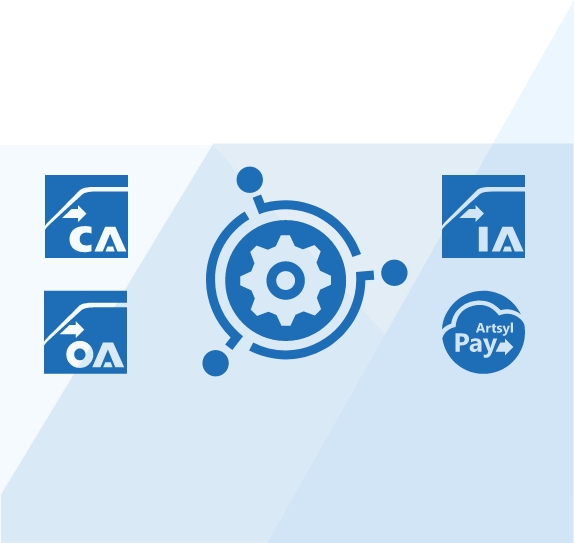Key Takeaways
Accounts receivable (AR) refers to the money owed by customers to a business for goods or services purchased on credit. One of the main challenges businesses face is managing their AR efficiently, which requires tracking incoming payments, following up on overdue invoices and managing collections.
Traditional AR solutions can be tedious, labor-intensive and prone to errors. However, with the advancements in machine learning technology, businesses can now automate many of their AR processes.
In this guide, we’ll discuss how machine learning is revolutionizing AR solutions and the benefits it offers to businesses.
Intelligent Process Automation Solution
Related Videos
How Machine Learning is Revolutionizing Accounts Receivable Solutions
One of the primary applications of machine learning in AR is automating invoice processing. With machine learning algorithms, businesses can extract data from incoming invoices and automatically match them with the corresponding purchase orders and receipts.
This way, machine learning significantly reduces the time and effort involved in manually processing invoices, ensuring faster payments and improved cash flow.
Here are other areas of AR that can be optimized by Machine Learning.
Step into the future of order management with Artsyl OrderAction! Discover how machine learning can transform your AR processes, boosting efficiency and reducing errors. Don’t let outdated methods hold you back – harness the power of ML with us today!
Book a demo now
AR Solutions: Where Machine Learning Shines
Machine learning can bring about transformative improvements in various aspects of accounts receivable (AR). Here are several areas within AR that can benefit from machine learning optimization.
Predictive Analytics for Payments
Machine learning can analyze historical payment data to predict which customers are likely to pay early, on time, or late. This allows businesses to focus their efforts on high-risk accounts and improve cash flow.
Predicting Payment Behaviour
Another advantage of machine learning in AR is its ability to accurately predict payment behavior. By analyzing historical payment patterns and customer data, machine learning algorithms can accurately predict which customers are more likely to make timely payments and which ones may cause payment delays. This helps businesses prioritize collections and adjust their AR strategies accordingly, leading to better cash flow management.
Automated Invoice Matching
Machine learning algorithms can auto-match payments to invoices based on patterns in the data, streamlining the reconciliation process and reducing manual efforts.
Fraud Detection
By analyzing transaction patterns, machine learning can flag potentially fraudulent activities in real-time, enhancing security measures and reducing losses.
Machine Learning Reporting and Analytics for Informed AR
With machine learning, businesses can streamline their reporting and analytics processes. AR solutions powered by machine learning can provide real-time insights into outstanding payments, invoices due and aging accounts receivable.
This capability of machine learning in AR helps businesses track their collections efforts and identify areas of improvement, leading to better cash flow management and reduced overdue accounts.
RELATED: Accounts Receivable Process Cycle
Optimized Customer Communication
Machine learning can determine the best time, platform, and method to contact customers for payment reminders based on their past interactions and response patterns.
Dynamic Credit Scoring
Traditional credit scoring can be static and might not reflect the current financial health of a customer. Machine learning can dynamically assess a customer’s creditworthiness based on various factors, offering a more comprehensive view.
Cash Flow Forecasting
By analyzing historical AR data, machine learning can provide more accurate predictions of future cash flows, aiding businesses in better financial planning.
Customer Segmentation and Personalization
Machine learning can segment customers based on their payment behavior, allowing businesses to create personalized strategies for each segment, enhancing the chances of timely payments.
Looking to revolutionize your accounts receivable operations? Dive deep into Artsyl docAlpha’s cutting-edge machine learning solutions. Experience firsthand how ML can streamline, predict, and enhance every facet of your AR journey. Let’s embark on this transformative journey together!
Book a demo now
Automated Payment Reminders: Simplifying AR
Machine learning-powered AR solutions can also automate payment reminders and follow-ups, freeing up valuable time and resources for businesses. Instead of manually sending out reminders and following up with customers, AI-powered automated systems can send out payment reminders, escalate overdue accounts and block credit to customers with repeated payment defaults. As a result, businesses can manage collections more efficiently and reduce the risk of bad debt.
Optimization of Discount Offers
Machine learning can analyze which customers are more likely to respond to early payment discounts, allowing businesses to offer targeted incentives that can improve cash flow.
Automated Data Entry
Machine learning models, particularly those using Optical Character Recognition (OCR), can automatically extract and input data from invoices, reducing manual errors and saving time.
Reduction of Unapplied Cash
By predicting the best match for unapplied cash based on historical data, machine learning can help reduce the amounts in suspense accounts.
Incorporating machine learning into accounts receivable processes not only enhances efficiency but also leads to more informed decision-making, reduced errors, and improved financial health for businesses.
RELATED: A Comprehensive Guide to Deep Learning vs. Machine Learning
Reducing Human Error in AR with Machine Learning
Traditional AR processes are often prone to errors and inaccuracies that can lead to incorrect payments, delayed cash flow and customer dissatisfaction. However, with machine learning-powered AR solutions, businesses can reduce the risk of errors and improve accuracy significantly.
By automating many of the manual processes involved in AR, businesses can reduce reliance on manual interventions and improve the overall efficiency of their AR operations.
The future of order management is here, and it’s powered by machine learning. With Artsyl OrderAction, watch as your time-consuming AR tasks become seamlessly efficient, predictive, and insightful. Embrace the revolution, and let’s build a smarter AR future together.
Book a demo now
How Do Businesses Use Machine Learning in Accounts Receivable?
Machine Learning (ML) has been a game-changer in Accounts Receivable (AR) by bringing in automation, predictive analysis, and efficiency. Here are some tangible business uses and examples.
Credit Risk Analysis
Here’s an example. A company uses ML algorithms to assess the creditworthiness of new clients based on their financial history, social media activity, and other behavioral data. This dynamic assessment helps in setting credit limits and terms tailored to each client.
Predictive Analytics for Payments
Sometimes, a business analyzes past payment behaviors of its clients to predict which invoices are likely to be paid late. By identifying these invoices in advance, the company can prioritize and tailor its collection efforts.
Automated Invoice Processing
A retail company receives thousands of invoices daily. Using ML-driven Optical Character Recognition (OCR), the company automatically scans, extracts data, and processes these invoices, reducing manual entry and errors.
RELATED: The Rise of Machine Learning in Business
Fraud Detection and Prevention
An e-commerce company uses ML to monitor transaction patterns. Suspicious activities, like sudden high-value transactions from a historically low-spending account, are flagged in real-time for review.
Dynamic Discounting
Based on purchasing behaviors and payment history, an ML model predicts which customers are more likely to avail early payment discounts. The company then offers targeted discounting strategies to incentivize early payments.
Customer Segmentation for Collection Strategies
A utility provider segments its customers into categories like «timely payers,» «occasional late payers,» and «chronic defaulters.» Using ML, it then tailors its communication and collection strategies to each segment, improving overall collection rates.
Cash Flow Forecasting
A manufacturing firm uses machine learning in AR to predict its monthly cash inflows based on historical AR data, ongoing contracts, and market trends. This aids in budgeting and ensures that they can meet their financial obligations.
Chatbots for AR Queries
A telecom company integrates an ML-driven chatbot on its website. The chatbot automatically answers common AR-related queries like «When is my bill due?» or «How much do I owe?», enhancing customer experience.
Optimized Payment Reminders
A subscription-based service analyzes user behavior and preferences to send payment reminders. Some users might receive an email, while others get an SMS or a push notification, depending on which method has historically garnered a quicker response.
Identification of Unapplied Cash
A multinational corporation uses ML to swiftly match and apply unallocated payments to the correct invoices, reducing the amount of money left «on the table» and improving financial accuracy.
These examples demonstrate the transformative potential of machine learning in AR, enabling businesses to make more informed decisions, optimize processes, and improve their bottom line.

Why settle for traditional when you can be transformational?
Elevate your accounts receivable processes with the unparalleled power of machine learning through Artsyl docAlpha. Dive into a world where predictions are precise, processes are streamlined, and productivity peaks. Are you ready to unlock the next-level AR potential?
What is Machine Learning in Accounting
Machine learning in accounting refers to the application of artificial intelligence algorithms to automate, optimize, and improve accounting tasks and functions.
By analyzing vast datasets, machine learning can identify patterns, make predictions, and streamline processes such as fraud detection, financial forecasting, accounts payable/receivable management, and tax preparations.
This way, machine learning in accounting not only reduces human error but also enhances efficiency and provides more profound insights into financial data for better decision-making.
Final Thoughts: Leveraging Machine Learning in AR Solutions
Machine learning-powered AR solutions offer enormous benefits to businesses, from automating tedious processes to improving cash flow management and reducing the risk of bad debt.
By adopting machine learning technology in their AR operations, businesses can streamline their collections processes, improve accuracy and efficiency and ultimately achieve better financial outcomes. It is clear that machine learning is revolutionizing AR solutions, and it is up to businesses to take advantage of the technology to stay ahead of the competition.
Harness the full potential of machine learning for your sales order management with Artsyl OrderAction. Transition from manual to magnificent, as you experience real-time predictions, automated insights, and flawless execution. Step up your AR game, and join the ranks of businesses embracing the future today!
Book a demo now
FAQ
What is Machine Learning (ML) in Accounts Receivable (AR)?
Machine learning in AR refers to the application of algorithms that allow systems to learn patterns from data and improve AR processes. It can automate tasks, predict outcomes, and enhance decision-making.
Why is machine learning important for AR?
Machine learning can streamline AR processes, reduce manual tasks, increase efficiency, and provide insights through predictive analytics. It helps in making better credit decisions, forecasting cash flow, detecting fraud, and more.
How does machine learning improve credit risk analysis?
Machine learning analyzes vast amounts of data, including transaction history, behavioral metrics, and market trends to assess the creditworthiness of clients more accurately than traditional methods.
Can machine learning predict late payments?
Yes. By analyzing historical payment data and other relevant indicators, machine learning can predict which invoices are likely to be delayed, allowing businesses to take preemptive actions.
How does machine learning assist in fraud detection?
Machine learning models monitor transaction patterns and flag irregularities or suspicious activities in real-time, significantly reducing the potential for fraud.
What is dynamic discounting in machine learning for AR?
Dynamic discounting uses machine learning to offer tailored discounting strategies based on predictive analyses. It incentivizes early payments by predicting which customers are likely to avail of discounts.
How does machine learning impact cash flow forecasting?
Machine learning analyzes historical AR data, ongoing contracts, and market trends to provide accurate and dynamic cash inflow predictions, aiding businesses in better financial planning.
Are there any challenges in integrating machine learning with AR?
Yes, like any technology, challenges can include data quality and integrity, choosing the right algorithms, and the need for skilled personnel. However, the benefits often outweigh the initial hurdles.
How does machine learning benefit customer segmentation in AR?
Machine learning can segment customers based on payment behaviors, purchase histories, and more. This enables businesses to tailor their communication and collection strategies for each segment, improving efficiency.
What future advancements can we expect with machine learning in AR?
The future may see further automation, real-time analytics, integration with IoT devices for real-time data collection, and more sophisticated predictive models.
Is integrating machine learning into AR expensive?
Initial setup might require investment in technology and expertise. However, in the long run, the increased efficiency, reduced manual effort, and valuable insights can result in substantial cost savings and increased revenue.



 Machine Learning AP Solutions
Machine Learning AP Solutions Machine Learning Applications
Machine Learning Applications Machine Learning Models: Navigating Their Power and Applications
Machine Learning Models: Navigating Their Power and Applications Machine Learning vs Artificial Intelligence: An Overview
Machine Learning vs Artificial Intelligence: An Overview Artificial Intelligence vs Machine Learning: A Comparison
Artificial Intelligence vs Machine Learning: A Comparison Statistics in Machine Learning: What Is Its Role?
Statistics in Machine Learning: What Is Its Role?
